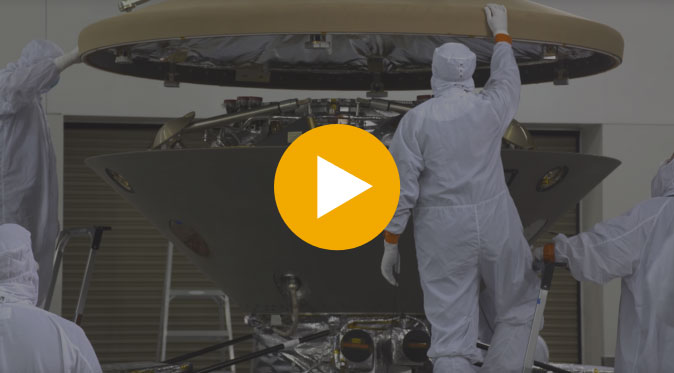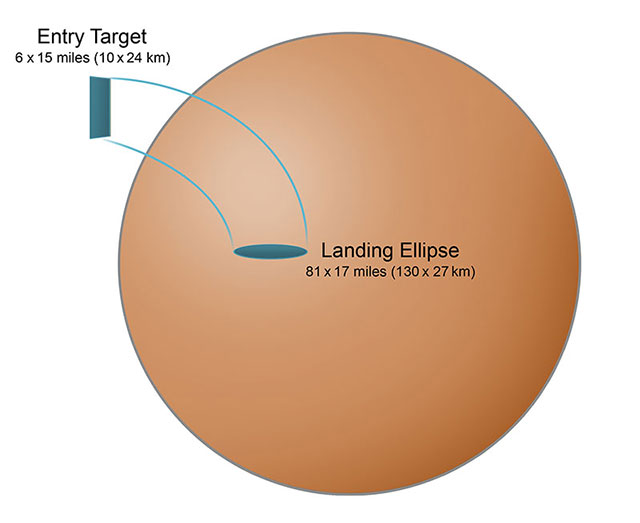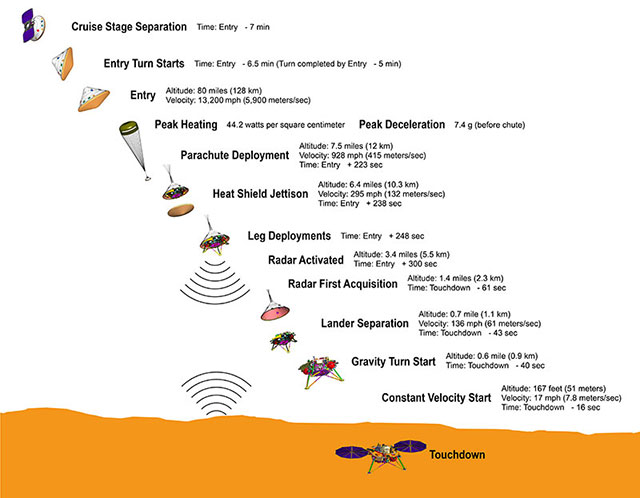Into the Atmosphere
Five minutes after completing the pivot to put its heat shield facing forward, InSight will start sensing the top of the atmosphere. Friction between the atmosphere and the heat shield during roughly 3.5 minutes before parachute deployment will take about nine-tenths of the velocity out of descent. Peak heating will occur approximately 1.5 minutes after atmospheric entry. The temperature at the external surface of the heat shield will reach about 2,700 degrees Fahrenheit (about 1,500 degrees Celsius). Deceleration will peak about 17 seconds later, at up to 7.4 g (about seven times the equivalent of acceleration due to gravity at Earth's surface). Ionization of gas around the spacecraft from the intense heating may cause a temporary gap in receipt of radio transmission from InSight.
Deployment of InSight's parachute from the top of the back shell may be triggered by either velocity or deceleration level and is expected at approximately 3.5 minutes after entry, at about 7.5 miles (12 kilometers) above ground level, at a velocity of about 930 miles per hour (about 415 meters/sec). The anticipated load on the parachute when it first opens is about 12,500 pounds of force (55,600 newtons). Approximately 10 seconds after parachute deployment, electronics of the spacecraft's landing radar will be powered on to warm up, and an auxiliary battery will be activated to supplement the lander's main battery during critical current-drawing events of the next few minutes.

Parachute testing for InSight, conducted inside world's largest wind tunnel, at NASA Ames Research Center, Moffett Field, California. Download image
The spacecraft will descend on the parachute for about three minutes. During the first 25 seconds of that period, InSight will jettison its heat shield and extend its three legs. About 75 seconds after the parachute opens and 130 seconds before landing, the spacecraft will start using its radar to sense the distance to the ground.
Descent speed will have slowed to about 134 miles per hour (60 meters per second) by the time the lander separates from the back shell and parachute, about three-fourths of a mile (1.2 kilometers) above the ground and about 45 seconds before touchdown. By design, the separation is triggered by radar sensing of altitude and velocity. A brief pause in communication is anticipated as data transmission shifts from the wrap-around antenna on the back shell to a helical UHF transmitter on the lander.
Slowing for Touchdown
Half a second after lander separation, the 12 descent engines on the lander will begin firing. Guidance software onboard for the terminal descent will provide commands for aligning the direction of thrust to the direction the spacecraft is moving, so the thrust will counter horizontal movement as well as decelerating the descent. If the spacecraft senses that its horizontal speed is below a threshold set in the software, it will also perform a maneuver to avoid the back shell that is still descending on its parachute. This maneuver would adjust the direction of thrust to reduce the chance that the back shell and parachute could land too close to the lander after the lander's touchdown. The spacecraft will rotate to land in the desired orientation: with solar arrays extending east and west from the deck and the robotic arm's work area on the south side of the lander.
At about 164 feet (50 meters) above the ground InSight will begin a transition to a constant descent velocity of 5.4 miles per hour (2.4 meters per second), the velocity at which it will touch down less than half a minute later.
The local solar time at the landing site in the Elysium Planitia area of Mars will be about 2 p.m. at touchdown (which will be about 12 noon in California). If it is a relatively clear day -- no dust storm -- the forecast calls for air temperature at the height of the lander deck to reach about 18 degrees above zero Fahrenheit (minus 8 Celsius) that afternoon and plummet to about minus 140 F (minus 96 C) overnight. The time of year in Mars' northern hemisphere will be about midway between the autumn equinox and winter solstice.
The Martian day, or sol, of the landing will count as Sol Zero of InSight's Mars surface operations.







